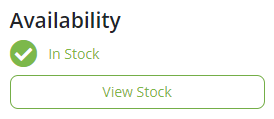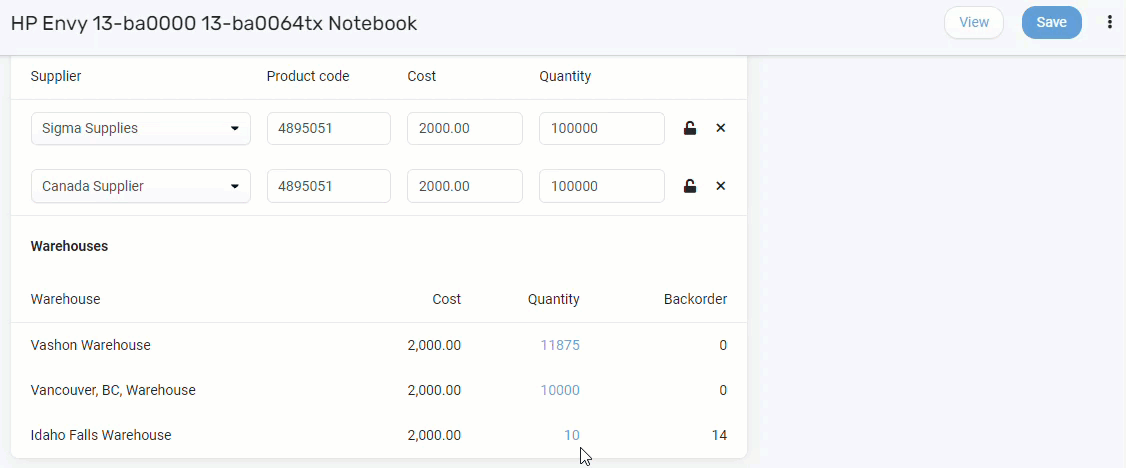Monitoring and transferring inventory
Reap several benefits when you manage your inventory with Kaseya Quote Manager. When inventory is carried in stock, Kaseya Quote Manager will:
- automate shipping from your inventory.
- facilitate serial number tracking with FIFO (first in, first out).
- apply mark-up rules from the average cost of goods purchased.
Kaseya Quote Manager will always select inventory carried in stock to fulfill an order, even if the cost is higher than another supplier.
EXAMPLE If 10 units are required to fulfill a sales order, but 3 are in stock, Kaseya Quote Manager will send a requisition to the appropriate Kaseya Quote Manager warehouse to ship the in-stock 3 units. The balance of 7 units will be drop-shipped from the best available supplier.
How to...
BEFORE YOU BEGIN Configure the warehouse in Kaseya Quote Manager: Adding warehouses
BEFORE YOU BEGIN Add your own business as a supplier in Kaseya Quote Manager: Add a supplier
Follow the instructions to Manually raise a supplier purchase order and Receipt a purchase order. When you do so, be sure to select your own business from the Supplier drop-down menu and select the applicable warehouse from the Warehouse drop-down menu.
NOTE Inventory in stock displays as In stock even if suppliers do not have stock.
You can view your stock levels (per warehouse) by selecting View Stock on a product page in the Online Store.

Alternatively, view the following comprehensive reports:
Inventory summary
From the left navigation menu, click Reports ![]() > Inventory summary. You can Export this report as a CSV file.
> Inventory summary. You can Export this report as a CSV file.
Stock on hand
From the left navigation menu, click Products ![]() > All Products. Select Filter products > Select a filter > Warehouse.
> All Products. Select Filter products > Select a filter > Warehouse.
An audit history is available for all inventory received, sent, and transferred. Access an audit history as follows:
- From the left navigation menu, click Products
 > All Products.
> All Products. - Search for the relevant product and click its MPN to open the product detail page.
- In the Warehouses section, click the stock Quantity for each warehouse to access the product transaction history.

Writing off inventory
Kaseya Quote Manager is not an accounting system and does not manage costs relating to inventory write-up and write-downs. You'll need to manage stock value adjustments in your accounting system.
To write off stock, sell the stock to your business or a write-off customer account either at cost or $0. While $0 will affect gross profit (GP) reporting, it will not require a journal entry in your accounting system.
If sold at cost, you'll need to make a journal from the debtor to an inventory write-down general ledger (GL) code.
Adding inventory found at a stock take
To increase inventory levels in a warehouse to correct actual stock values:
- Check that the inventory is not in another warehouse configured in Kaseya Quote Manager. If required, transfer the inventory to the correct warehouse.
- To increase inventory values in a warehouse, purchase the stock by following the process described in Transfer inventory to a warehouse.
Other options for managing inventory
- Integrate Kaseya Quote Manager with your PSA system, such as Autotask or ConnectWise PSA.
- You can also use an ERP system with warehouse management or an external warehouse management system.
When an external application manages your Kaseya Quote Manager inventory, you should create a supplier feed in which:
- Your business is the supplier with stock on hand (SOH).
- Cost of goods (COG) is imported as a supplier to Kaseya Quote Manager.
Remember to prioritize yourself as a supplier so that the stock is not drop shipped from another supplier because the cost is lower. Refer to Adjusting supplier status for prioritization instructions.



